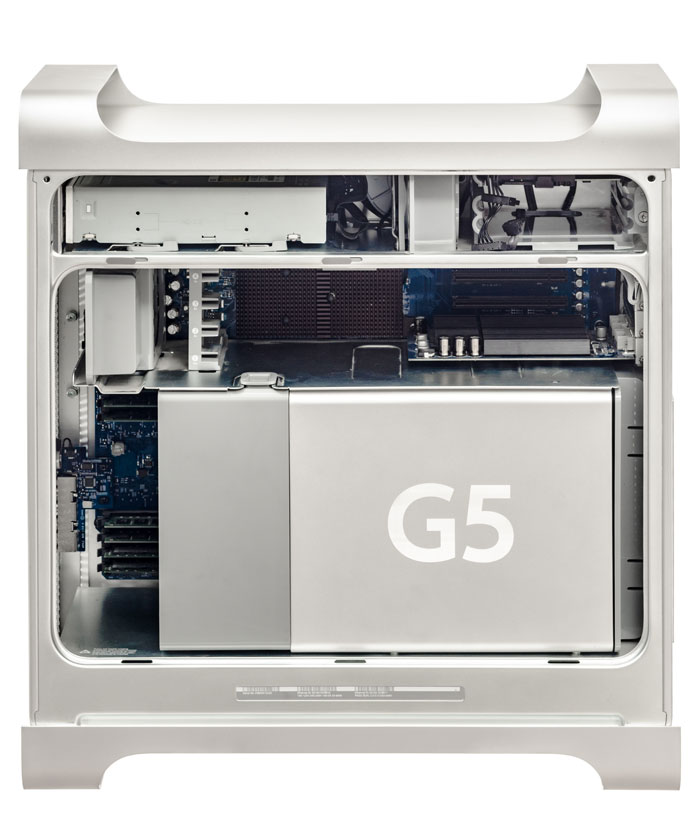Rediscovering the beautiful design of the Apple Power Mac G5
Over a decade ago, in 2003, the Power Mac G5, was introduced to the masses as the most powerful Mac computer of its time, with specs that included the PowerPC G5, also known as the PowerPC 970, as per IBM’s classification. The Power Mac G5’s processor was the result of IBM’s $3 billion investment in a brand new laboratory needed for production of the 64-bit CPU’s 300mm wafers, which, at the time, boasted clock speeds up to 2.5GHz, with the goal of reaching 3GHz within 12 months.
While that 12 months goal was never reached, the Power Mac G5 was, and still is revered as one of the most beautiful computers ever made by Apple, before the switch to Intel Xeon processors and the introduction of the Mac Pro in 2006.
Beautiful, inside and out
What made the G5 truly unique, was a painstaking attention to details on its exterior as well as the internal components. Compared to most PCs of that era, the G5 looked better on the inside than most PCs looked on the outside, and it was leaps and bounds any other comparable computer, when it came to managing internal components and cables.
That attention to detail comes to light when removing the side panel from the chassis, and catching a glimpse of how the internal components are built and organized within the frame. The first thing that pops into view is the large panel covering the processor. When removing that panel, the large custom heat sink covering the PowerPC G5 processor comes into view.

Efficiency and internal management
While on most PCs that area would be cluttered with wires and connectors powering a top-side CPU fan, the area surrounding the G5’s heatsink is one solid block, with no wires to be seen anywhere, except for a small bundle on the bottom floor of the chassis.
Most components and peripherals could be removed easily and efficiently, with barely any need for tools. Those included the optical drive, which only required activating a small switch at the bottom of the optical drive’s housing, the hard disk, which could be extracted and inserted back in by simply sliding the unit out and snapping it back into place, and the RAM, which could be accessed very easily by sliding out the CPU’s ventilation block.
While delving through the internals of the G5, it’s worth taking notice of several details that truly made this computer great. For example, when removing the external side panel from the chassis, the inside of the same panel has printed instructions on how to access all the internal components, and best of all, the instructions are printed upside-down, so that when laying the panel down from its original position, the instructions would be right under the user’s eyes in the right position, without the need to flip the panel around.
Inspiring design
Very few custom cass of that period sported a similar design, and those included manufacturers like Thermaltake, maker of the aluminum and laser-cut stainless steel Xaser-III case, which featured many of the innovations brought forth by the Power Mac G5, such as the ability to remove internal parts of the frame by means of simple clips, snap-ins and hinges, as well as screws that could be loosened and fastened by hand, without the use of a screwdriver.
In 2003, WiFi was not nearly as popular as it is today, however, the Power Mac G5 was way ahead of its time, allowing an AirPort card to be slid into motherboard, through a built-in slot. At a time when dial-up was still an acceptable way to connect to the Internet, with the first spurs of broadband Internet services like ISDN and ADSL being tested worldwide, the Power Mac G5 did not require a separate dial-up modem, as it integrated one within the chassis.
Then and Now
When the Mac Pro was introduced, as part of Apple’s switch to Intel processors from its former historical partnership with IBM, critics saw the Mac Pro as a product that took some of that sleek, user-friendly appeal away from the beloved Power Mac G5. With that in mind, there are a few considerations to be made.
First, it’s not 2003 anymore. Internal components have shrunk in size considerably, while others turned obsolete, requiring less hardware in a more integrated, yet upgradeable unit. When lifting the lid off of the tubular design of the Mac Pro, all the internals are there, accessible and neatly organized, like the RAM, the GPU and the internal storage. Throughout all of its iterations, the Mac Pro has retained much of the original accessibility and neatness found in the G5, while making substantial improvements in airflow and desktop footprint.